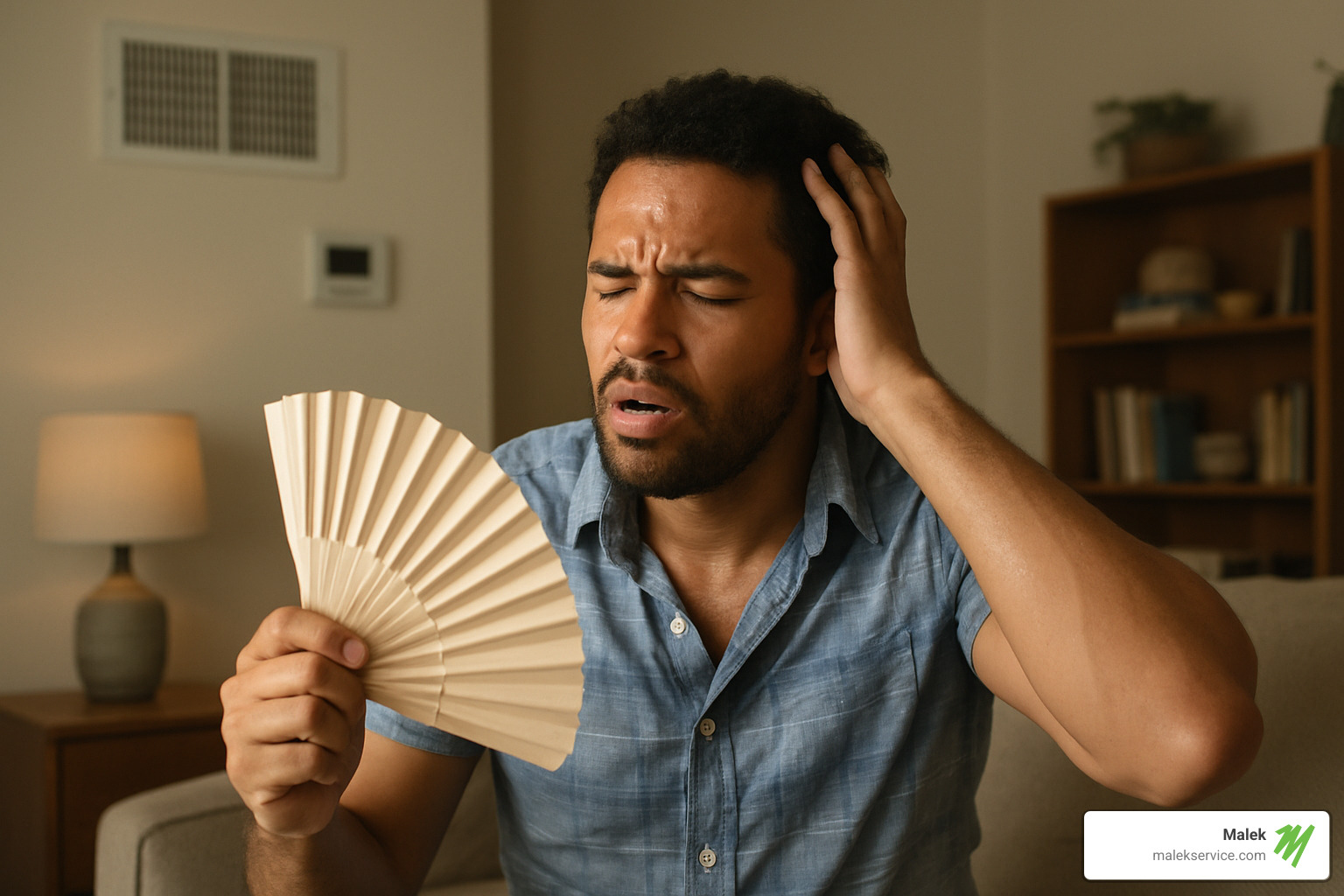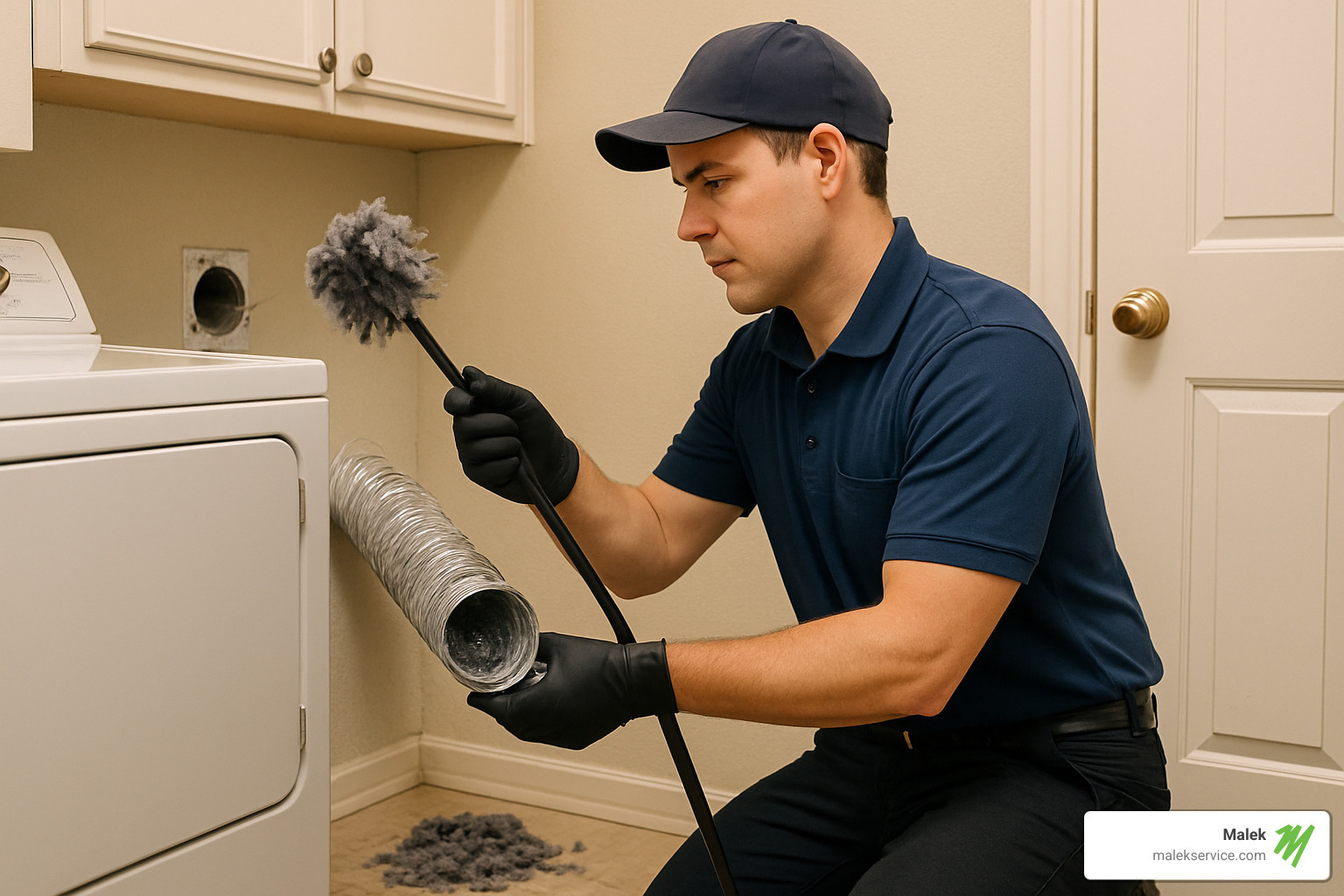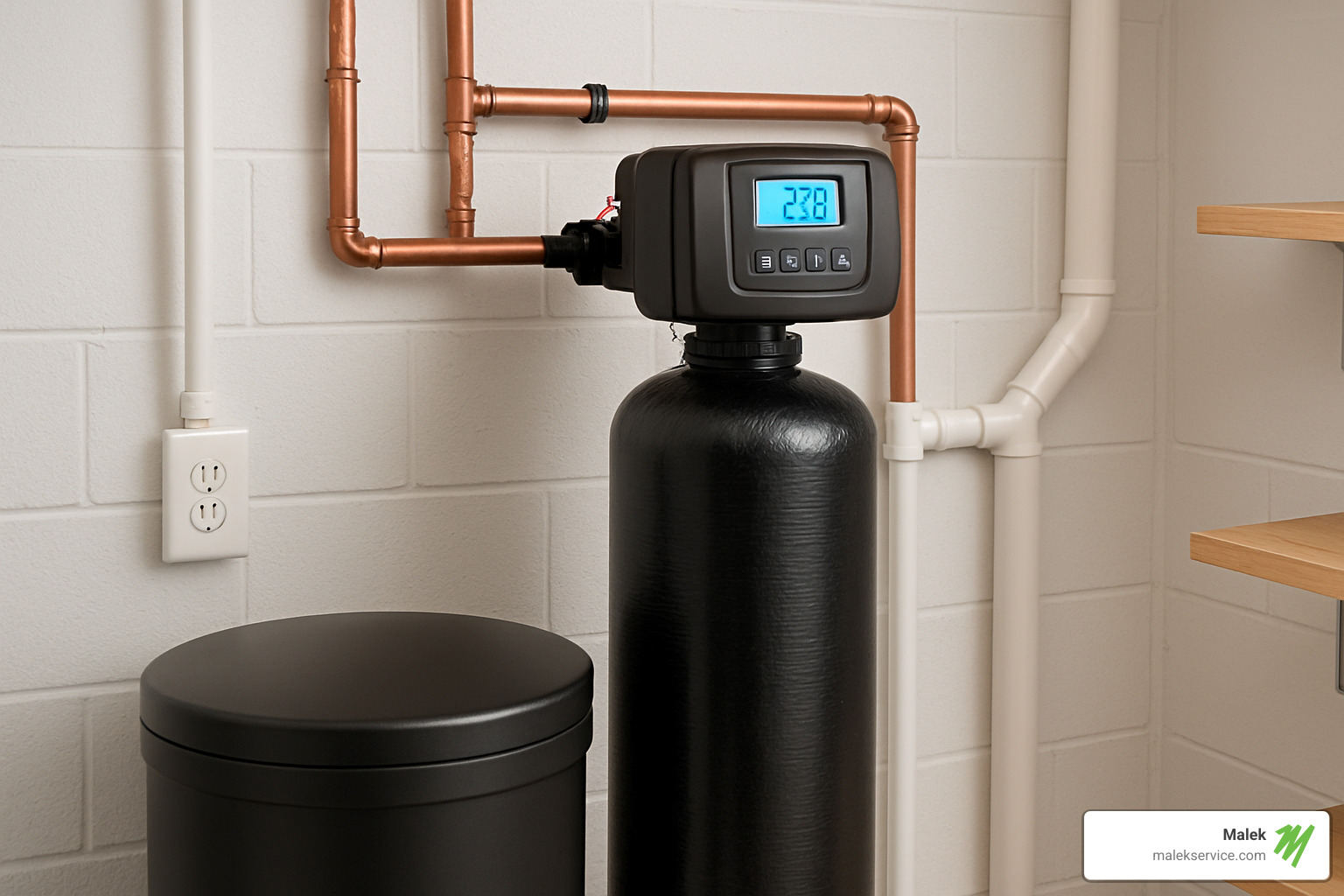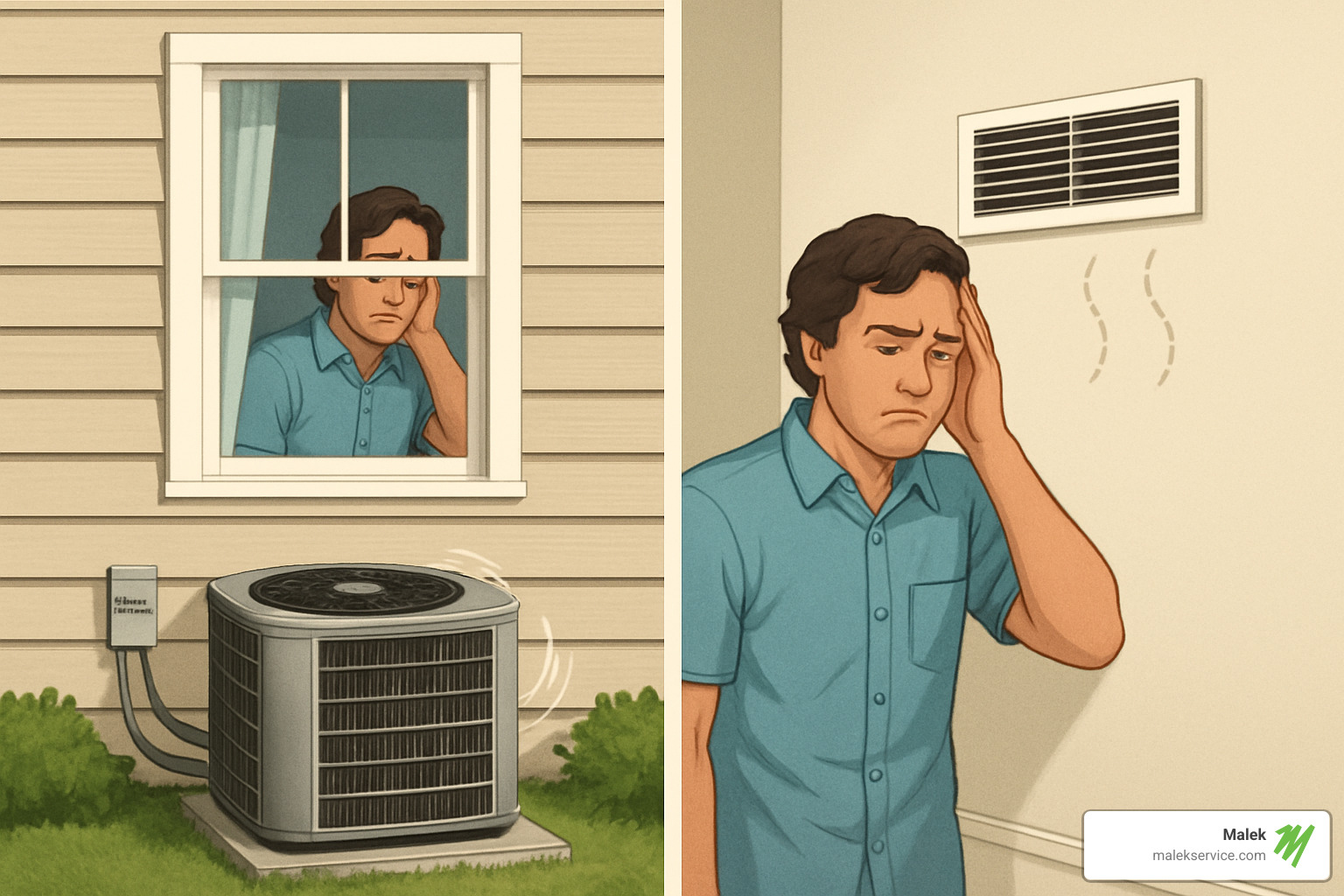Why One Room Stays Hot While Others Stay Cool
If your room not cooling down is driving you crazy, you’re not alone. Here are the most common culprits behind this frustrating problem:
Quick Diagnosis Checklist:
– Blocked vents – Furniture or closed dampers restrict airflow
– Dirty air filter – Reduces system efficiency by up to 15%
– Leaky ducts – Cool air escapes before reaching your room
– Poor insulation – Heat enters through windows, walls, or attic
– Wrong-sized AC unit – Too small or too large for your home’s needs
– Thermostat issues – Poor placement or calibration problems
– Heat sources – Electronics, appliances, or direct sunlight
The good news? Many of these issues have simple fixes that don’t require a service call.
Why does this happen? Your home is a complex system where air, heat, and moisture constantly move around. When one room won’t cool down, it usually means something is blocking the cool air from getting in or preventing hot air from getting out. Sometimes it’s as simple as a closed vent. Other times, it’s hidden problems like leaky ducts or poor insulation.
Three-quarters of all homes in the US have air conditioners, but uneven cooling remains one of the most common complaints. Windows alone account for 10-25% of your heating and cooling bills, and some 40% of summer heat gain comes through windows.
I’m Courtney Zalesak, Vice President at Malek Service Company, where I’ve spent over a decade helping Texas homeowners solve exactly these kinds of room not cooling down problems. Through our HVAC, plumbing, and electrical services, I’ve seen how the right diagnosis can turn a frustrating hot spot into a comfortable space.
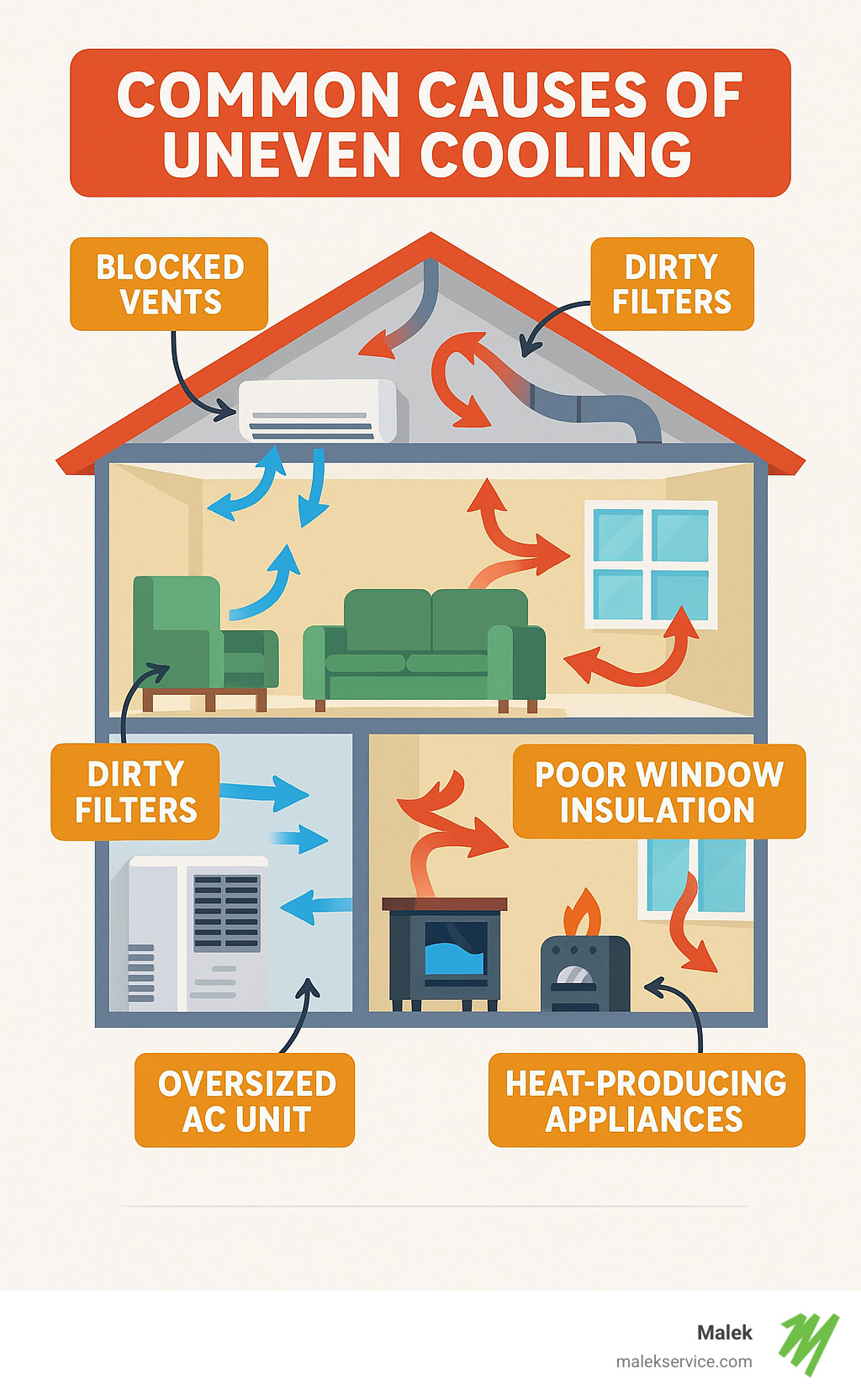
Why Is Your Room Not Cooling Down?
After helping thousands of Texas homeowners – from College Station to Houston to Huntsville – I’ve seen the same frustrating pattern. You set your thermostat to a comfortable temperature, but that one stubborn room not cooling down makes your whole house feel uncomfortable.
The good news is that understanding why this happens puts you halfway to solving it. Your home’s cooling system is like a carefully choreographed dance between physics, airflow, and engineering. When one element gets out of step, certain rooms pay the price.
Thermal dynamics work against you in predictable ways. Heat always moves from warm areas to cool areas, which means your AC is constantly fighting heat trying to sneak into your home through windows, walls, and cracks. Multi-level homes face an extra challenge because hot air naturally rises, making upstairs rooms work twice as hard to stay comfortable.
Your HVAC system was designed to move a specific amount of air through your home at a specific rate. When something disrupts this balance – whether it’s closed vents, dirty filters, or an oversized system that cycles on and off too quickly – some rooms get left behind.
According to scientific research on window heat gain, windows can account for 25-35% of your cooling costs during summer months. That west-facing bedroom that turns into a sauna every afternoon? Those windows are working like solar collectors, pumping heat into your room faster than your AC can remove it.
The Physics Behind a “room not cooling down”
Here’s what’s really happening when your room not cooling down drives you crazy. Heat transfer occurs in three ways, and your problem room is probably getting hit by all three at once.
Heat conduction moves warmth through solid materials like walls, floors, and ceilings. Poor insulation creates a highway for heat to travel directly into your room. Convection happens when hot air moves around your space. Radiation is the direct heat from sunlight streaming through windows, and it’s often the biggest culprit.
Solar load creates the most dramatic temperature swings. When sunlight hits your windows, it heats everything inside the room – your furniture, carpet, walls. These materials act like heat sponges, soaking up energy during the day and releasing it slowly for hours afterward.
Humidity makes everything worse. When indoor humidity climbs above 60%, the same temperature feels much hotter because your body can’t cool itself effectively.
Common Symptoms of a “room not cooling down”
Uneven temperatures between rooms are the most obvious red flag. When your hallway thermostat reads 72°F but your bedroom feels like 78°F, something’s wrong with your system’s balance.
Long runtime periods tell us your system is struggling. If your AC runs constantly but never seems to catch up, especially in one particular area, the problem usually involves blocked airflow or excessive heat gain.
High energy bills often go hand-in-hand with uneven cooling. When your system can’t efficiently cool every room, it runs longer and works harder, driving up electricity costs.
DIY Troubleshooting Checklist
When your room not cooling down has you feeling frustrated, don’t panic. Most cooling problems have straightforward solutions you can tackle yourself before calling in the professionals. The key is working systematically through the most common culprits.
Safety comes first, though. Always turn off power to your HVAC system before working on any electrical components.
Step-by-Step: Quick Fixes When Your “room not cooling down”
Start with your air filter – it’s the easiest check and often the biggest problem. Pull out your current filter and hold it up to a bright light. Can you see through it clearly? If not, you’ve found your culprit. A clogged filter chokes your system, reducing airflow by up to 15%.
In Texas heat, we recommend checking filters monthly. Homes with pets or lots of dust might need new filters every month, while others can go two to three months.
Next, check your vents. Walk through your home and check every supply vent in the problem room. Is furniture blocking the airflow? Are the dampers actually open? Clear away any curtains, furniture, or dust buildup that might be blocking return vents too.
Windows and doors deserve attention. Run your hand around window frames and door edges, feeling for air leaks. Even tiny gaps can let hot outdoor air sneak in faster than your AC can cool it. Simple caulk or weatherstripping can work wonders.
Check your ceiling fan direction – in summer, ceiling fans should spin counterclockwise when you look up at them. This pushes air down, creating a cooling breeze that can make a room feel 4-6 degrees cooler.
Finally, check your thermostat. Is it getting hit by direct sunlight? Is it near a heat-producing appliance? These heat sources can fool your thermostat into thinking your whole house is warmer than it really is.
For more detailed troubleshooting steps, check out our comprehensive A/C Troubleshooting guide.
Comparing Ideal vs. Problem Readings
| Measurement | Ideal Range | Problem Indicators |
|---|---|---|
| Room Temperature Variance | Within 2-3°F of thermostat setting | More than 5°F difference between rooms |
| Supply Air Temperature | 15-20°F cooler than return air | Less than 10°F difference |
| Humidity Level | 30-50% relative humidity | Above 60% or below 30% |
| Airflow at Vents | Strong, consistent flow | Weak flow or no air movement |
| Filter Condition | Light passes through clearly | Cannot see light through filter |
| Duct Temperature | Cool to touch at supply vents | Warm ducts in conditioned spaces |
Hidden Structural Issues & Airflow Imbalances
Sometimes the reason your room not cooling down has nothing to do with your thermostat settings or dirty filters. The real culprits are hiding where you can’t see them – behind walls, in crawl spaces, and throughout your ductwork system.
After fifteen years of diagnosing cooling problems across Texas, the most stubborn issues usually stem from problems you’d never think to check. Your home’s cooling system is essentially a carefully balanced network designed to move the right amount of cool air to each room. When something disrupts this balance, certain rooms inevitably become uncomfortable.
We regularly find homes where 30-40% of the cooled air never reaches its intended destination. In Texas heat, these hidden losses can add hundreds of dollars to your annual cooling bills while leaving you frustrated.
Ductwork: The Silent Saboteur
Your ductwork is like the circulatory system of your home’s cooling. Duct leaks are probably the most common hidden cause of uneven cooling we encounter.
Leaky joints are especially problematic in Texas homes. Our extreme temperature swings cause duct connections to expand and contract repeatedly, gradually loosening seals over time. We’ve crawled through countless attics where ducts have simply pulled apart at the joints.
Crushed or kinked ducts create bottlenecks that choke off airflow to specific rooms. This happens more often than you’d think, especially with flexible ducts that can get compressed when storage items are placed on them.
Uninsulated duct runs through hot attics are another major problem. Your AC produces beautiful 55-degree air, but it has to travel through a duct sitting in a 140-degree attic. By the time that air reaches your room, it might be 70 degrees or warmer.
For more detailed information about these airflow challenges, check out our guide on Why Does My AC Have Low Airflow?
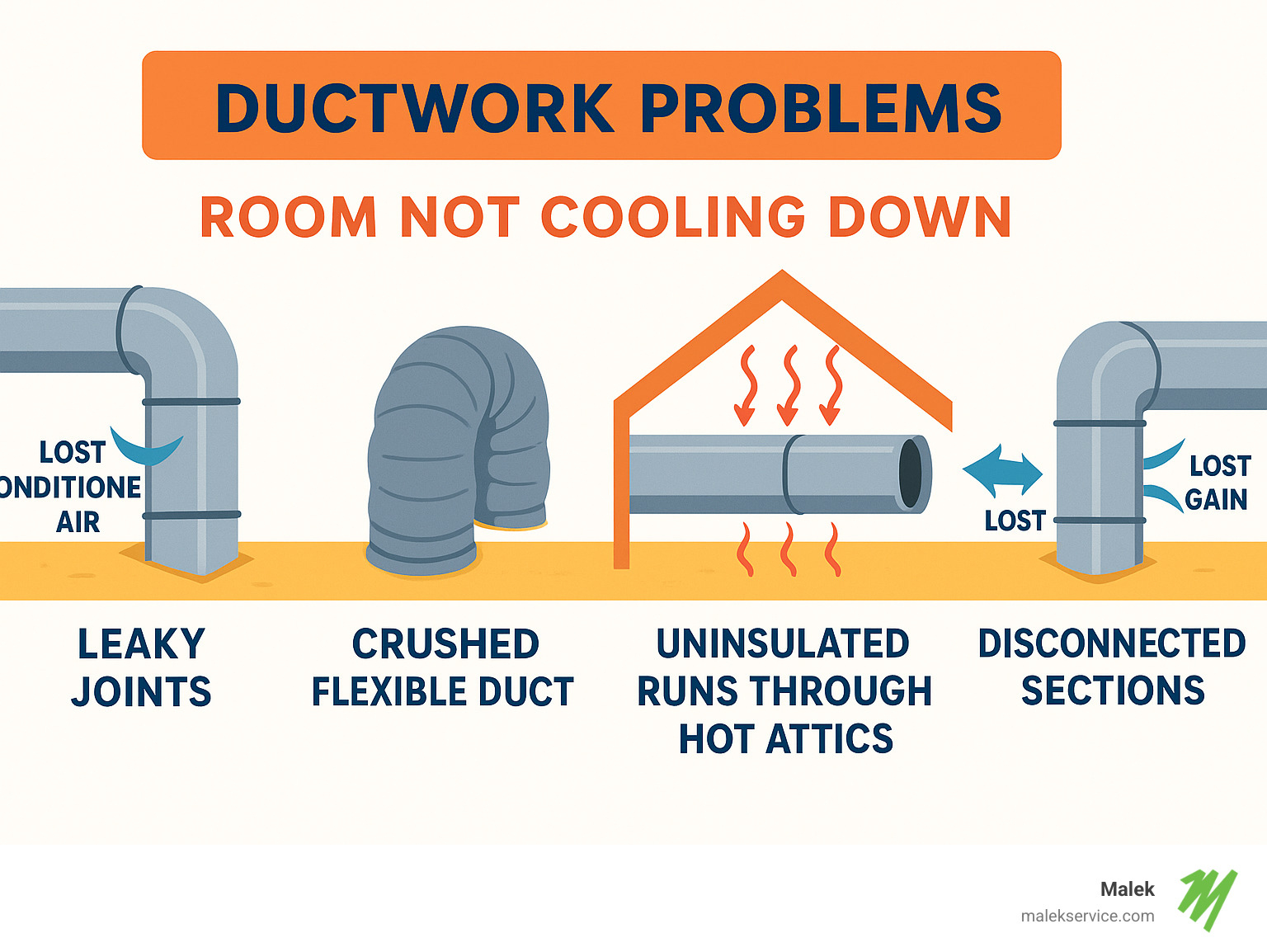
Air Balancing Basics
Professional air balancing is like tuning a musical instrument – small adjustments can make a huge difference. Dampers throughout your duct system work like adjustable valves, controlling how much air flows to each area of your home.
Static pressure testing reveals whether your system is working too hard to push air through the ductwork. High static pressure forces your equipment to strain, leading to higher energy bills and premature system failure.
Manual dampers can be adjusted to fine-tune airflow to different zones. If your upstairs rooms consistently run warmer, partially closing dampers to downstairs areas can redirect more cool air upstairs where it’s needed most.
Windows, Doors & Insulation Gaps
Windows are responsible for about 40% of summer heat gain in most homes. Single-pane windows offer almost no resistance to Texas heat, while double-pane windows with Low-E coatings can reduce heat gain by 25-30%.
Weather-stripping around windows and doors creates gaps that allow hot outdoor air to constantly infiltrate your home when deteriorated. These leaks can make specific rooms impossible to cool effectively.
R-value measures your insulation’s ability to resist heat flow. Texas homes should have at least R-30 insulation in attics, but many older homes have far less.
Here’s something many homeowners don’t realize: air sealing is often more important than adding insulation. The Department of Energy estimates that air leaks account for 25-30% of cooling energy loss in typical homes.
For comprehensive information about detecting and sealing air leaks, the Department of Energy provides excellent scientific research on air-sealing techniques and benefits.
Advanced Solutions: Zoning, Upgrades & Energy Efficiency
Sometimes the simple fixes just aren’t enough. When your room not cooling down problem persists despite basic troubleshooting, it’s time to consider bigger solutions that can truly transform your home’s comfort.
Today’s advanced HVAC technologies offer solutions that can eliminate hot spots permanently while often paying for themselves through energy savings.
HVAC zoning systems give you independent temperature control for different areas. Instead of your entire house being controlled by one thermostat, zoning lets you keep your master bedroom at 68°F for sleeping while allowing rarely-used guest rooms to stay at 76°F.
Mini-split systems work beautifully for stubborn rooms that your central system just can’t handle. These ductless units mount quietly on your wall and can cool individual spaces with remarkable efficiency.
Smart thermostats have evolved far beyond simple programmable models. Today’s advanced systems can manage multiple zones, learn your family’s schedule, and even adjust automatically based on outdoor conditions.
When your existing AC system simply can’t keep up with brutal Texas summers, our comprehensive guide on AC Can’t Keep Up With Heat? provides additional strategies.
When to Upsize / Downsize Your System
Bigger isn’t always better when it comes to air conditioning. The old rule of thumb – 20 BTU per square foot – doesn’t work for modern homes with better insulation and efficient windows.
Proper HVAC sizing requires what’s called a Manual J load calculation. This detailed analysis considers your home’s square footage, insulation levels, window types and orientation, ceiling heights, and local climate data.
Oversized systems create their own problems. When your AC is too large, it cools the air quickly but shuts off before removing humidity. You end up with a cold, clammy house that somehow still doesn’t feel comfortable.
Undersized systems run constantly but never catch up, especially during brutal July afternoons when it’s 105°F outside.
Adding Zones to Tame a Stubborn Room
Zoning systems use motorized dampers installed in your ductwork, controlled by multiple thermostats throughout your home. When your upstairs bedroom calls for cooling, dampers open to direct airflow there while closing off areas that are already comfortable.
You can keep bedrooms cooler at night while allowing daytime living areas to be warmer when unoccupied. Parents can maintain comfortable sleeping temperatures without over-cooling the entire house.
Zoning systems often reduce energy costs by 20-30% because you’re not cooling unused spaces. They also reduce wear on your HVAC equipment.
Energy-Wise Tweaks That Help Every Room
Don’t overlook simple changes that can make every room easier to cool. These energy-wise improvements work together to reduce your home’s overall cooling load.
LED lighting produces 90% less heat than old incandescent bulbs. In rooms with multiple light fixtures, this change alone can make a noticeable difference.
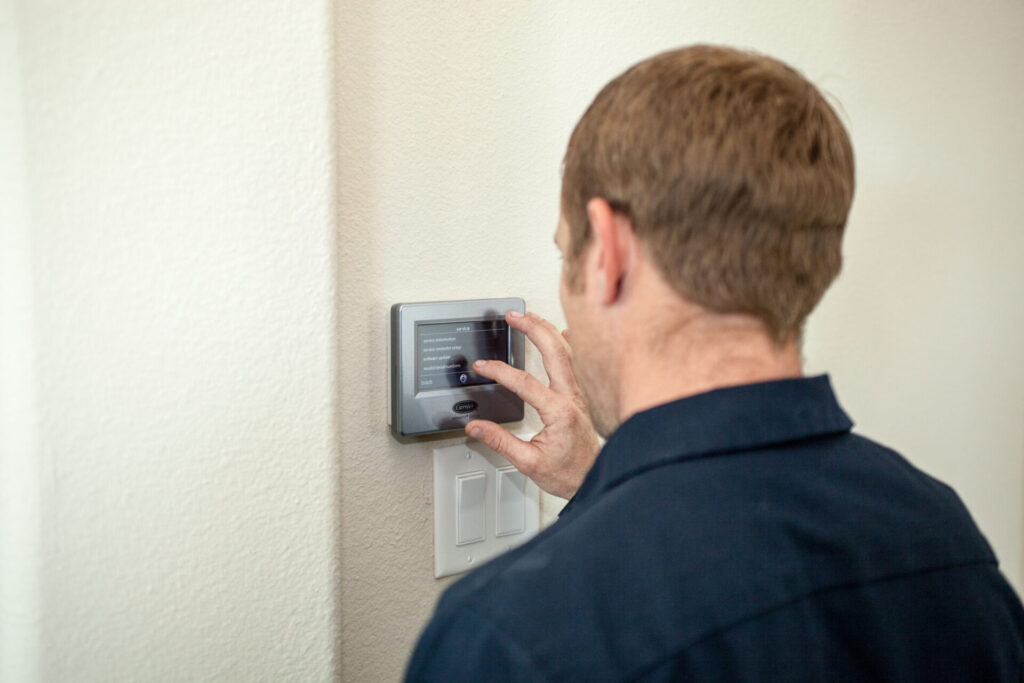
Smart scheduling helps manage cooling costs while maintaining comfort. Modern thermostats can learn your routine and automatically adjust temperatures when you’re away.
Window treatments can reduce heat gain by up to 25% when properly selected. Blackout curtains, cellular shades, and reflective window films all help block solar heat before it enters your home.
Appliance timing makes a bigger difference than most people realize. Running your dishwasher, clothes dryer, and oven during cooler evening hours means your AC doesn’t have to fight against extra heat during the hottest part of the day.
Frequently Asked Questions about Uneven Room Cooling
After helping thousands of Texas homeowners solve their cooling problems, we hear the same questions repeatedly. Here are the big three that come up in almost every conversation about uneven cooling.
Why does one upstairs bedroom stay hot even with the AC running?
Upstairs bedrooms face a perfect storm of factors working against them. Heat rises naturally, so your second floor is literally fighting physics every day. Those long duct runs to upstairs rooms give cooled air plenty of time to warm up during its journey, especially when ducts snake through blazing hot attic spaces.
Many upstairs rooms have inadequate return air paths. Cool air needs somewhere to go once it enters the room. Without proper return ducts or transfer grilles, you create pressure imbalances that choke off airflow.
Solar heat gain through upstairs windows adds insult to injury. West-facing bedrooms get hammered by intense afternoon sun right when outdoor temperatures peak.
The good news? This problem usually responds well to a combination approach. Improving ductwork insulation, adding return air paths, upgrading window treatments, and sometimes installing zoning controls can transform that sweltering bedroom.
Can dirty air filters or ducts really keep a room from cooling down?
Absolutely. A dirty air filter reduces system efficiency by up to 15% and creates uneven cooling throughout your home. When airflow gets restricted, your system struggles to deliver adequate cooling to rooms at the end of duct runs.
Dirty ducts create a double problem. Dust and debris buildup restricts airflow like partially blocked arteries, while all that gunk actually insulates duct surfaces and reduces heat transfer efficiency.
But leaky ducts are even worse than dirty ones. When your expensive conditioned air escapes into unconditioned spaces like attics, less air reaches your living areas. We’ve seen homes where 40% of cooled air never made it to its destination.
When should I call a professional instead of DIY?
We love it when homeowners try the basic fixes first. Checking vents, replacing filters, and sealing obvious air leaks can solve many room not cooling down problems without a service call. But there’s a clear line between helpful DIY and potentially dangerous territory.
Call us when basic troubleshooting doesn’t work or when you encounter anything involving refrigerant, electrical components, or major ductwork repairs. These systems require specialized tools, training, and safety equipment.
If your problem persists after you’ve tried the obvious fixes, professional diagnosis can uncover hidden issues that aren’t visible to the naked eye.
Definitely call a professional immediately if you notice ice formation on equipment, unusual noises from your HVAC system, frequent circuit breaker trips, hissing sounds that might indicate refrigerant leaks, or any electrical issues.
Conclusion
Dealing with a room not cooling down can feel like an endless battle, but most cooling problems have straightforward solutions once you understand what’s really happening.
Think of your home as a living system where air, heat, and moisture are constantly moving around. When one room stays stubbornly warm, it’s usually because something is disrupting this natural flow – whether that’s a blocked vent, leaky ductwork, or too much heat pouring through windows.
Start with the simple fixes first. Check those vents, swap out that dirty filter, and seal up any obvious air leaks. You’d be amazed how often these basic steps solve the problem completely.
But sometimes the issue runs deeper. Hidden duct leaks, poor insulation, or an improperly sized system require professional diagnosis to identify and fix properly.
At Malek Service, we’ve been solving these exact problems for Texas homeowners from College Station to Huntsville for years. Our licensed technicians understand how homes work in our climate, and we stay current with the latest technology through regular training programs.
Your comfort matters, and so does your budget. Professional diagnosis often saves money in the long run by identifying the real problem instead of guessing. We’ll give you honest advice about whether your room not cooling down needs a simple repair or a more comprehensive solution.
Don’t let one stubborn room make your whole summer miserable. Whether you need a quick repair, system upgrade, or ongoing maintenance to prevent future problems, we’re here to help restore comfort to every corner of your home.
For preventive care that catches problems before they leave you sweating, check out our AC Maintenance Services and find how regular professional attention keeps your system running smoothly all season long.
